Abstract
The hypothesis that clinical and biochemical essential fatty acid deficiency (EFA) might occur from the feeding of eucaloric, fat-free diets was tested in two experiments in healthy men. In Study I, eight men were given fat-free, eucaloric diets containing 80% of calories as glucose and 20% as amino acid hydrolysates by a constant drip over a 24-h period. The diets were fed in succession for periods of 2 wk each, either through a superior vena cava catheter or via a nasogastric tube. EFA deficiency was detected by decreases in linoleic acid and by the appearance of 5, 8, 11-eicosatrienoic acid in lipid fractions of plasma. Linoleic acid decreased significantly during 2 wk of the fat-free diet given intravenously from 48.8 to 9.8% (percent of total fatty acids) in cholesterol esters, from 21.2 to 3.2% in phospholipids, from 9.6 to 2.0% in free fatty acids, and from 14.1 to 2.6% in triglycerides. Eicosatrienoic acid, normally undetectable, appeared 0.6% in cholesterol esters, 2.5% in phospholipids, 0.2% in free fatty acids, and 2.3% in triglycerides. EFA deficiency occurred similarly during the nasogastric feeding. In Study II a subject received the same diet continuously by the nasogastric route for 10 days followed by a 24-h fast. He was then given the fat-free diet intermittently in three meals per day for 3 days. Finally, he was repleted with a diet containing 2.6% linoleic acid. By the 3rd day of the continuous nasogastric feeding, linoleic acid had fallen significantly and eicosatrienoic acid had appeared in plasma lipid fractions as in Study I. These findings were accentuated by day 10. Adipose tissue fatty acid composition did not change. Free fatty acid outflow from adipose tissue was presumably suppressed during the 10 days of continuous feeding. With increased free fatty acid outflow during fasting and intermittent feeding, linoleic acid rose and eicosatrienoic acid decreased. After 13 days of repletion with dietary linoleic acid, the EFA deficiency readily develops when fat-free diets containing glucose are given intravenously or orally as constant 24-h infusions. These diets are similar to the hyperalimentation formulas now being used clinically.
Full text
PDF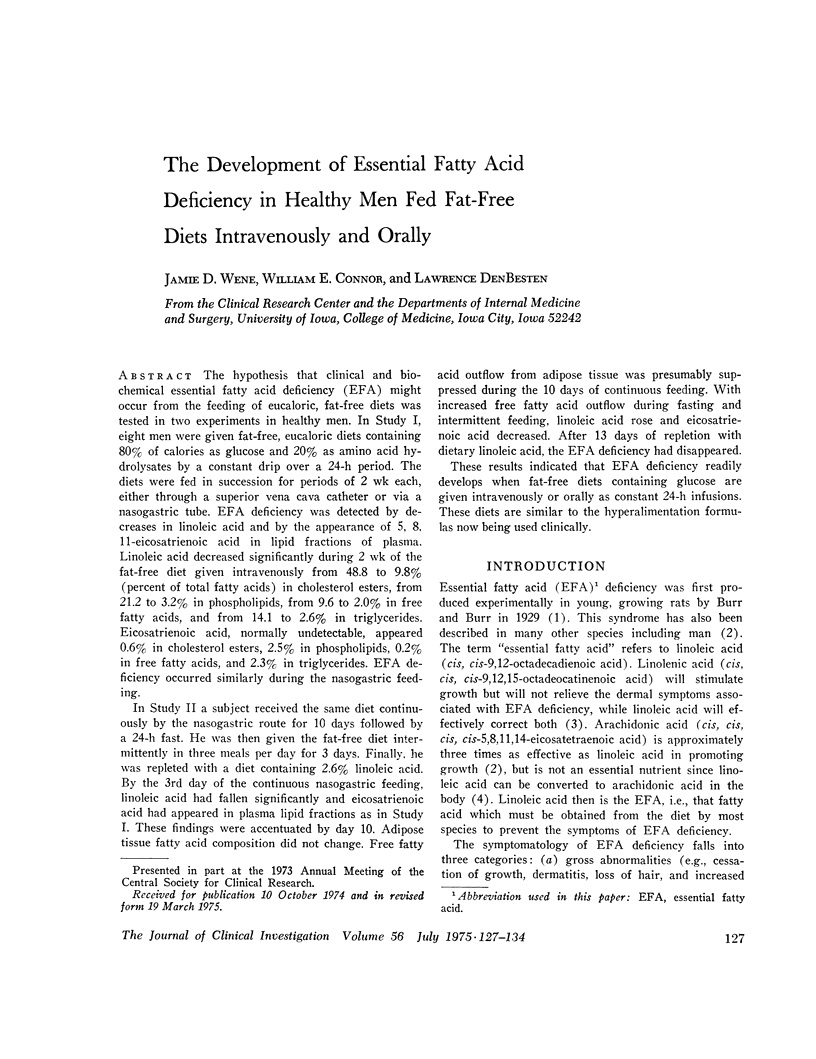
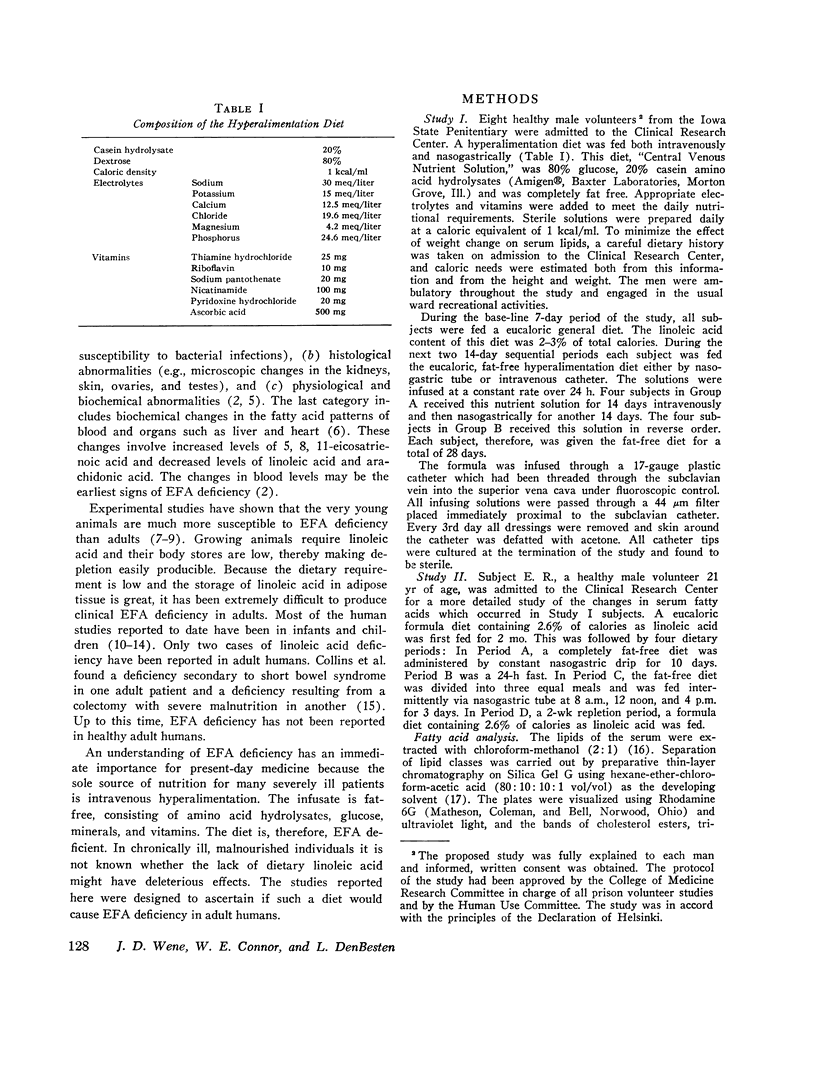
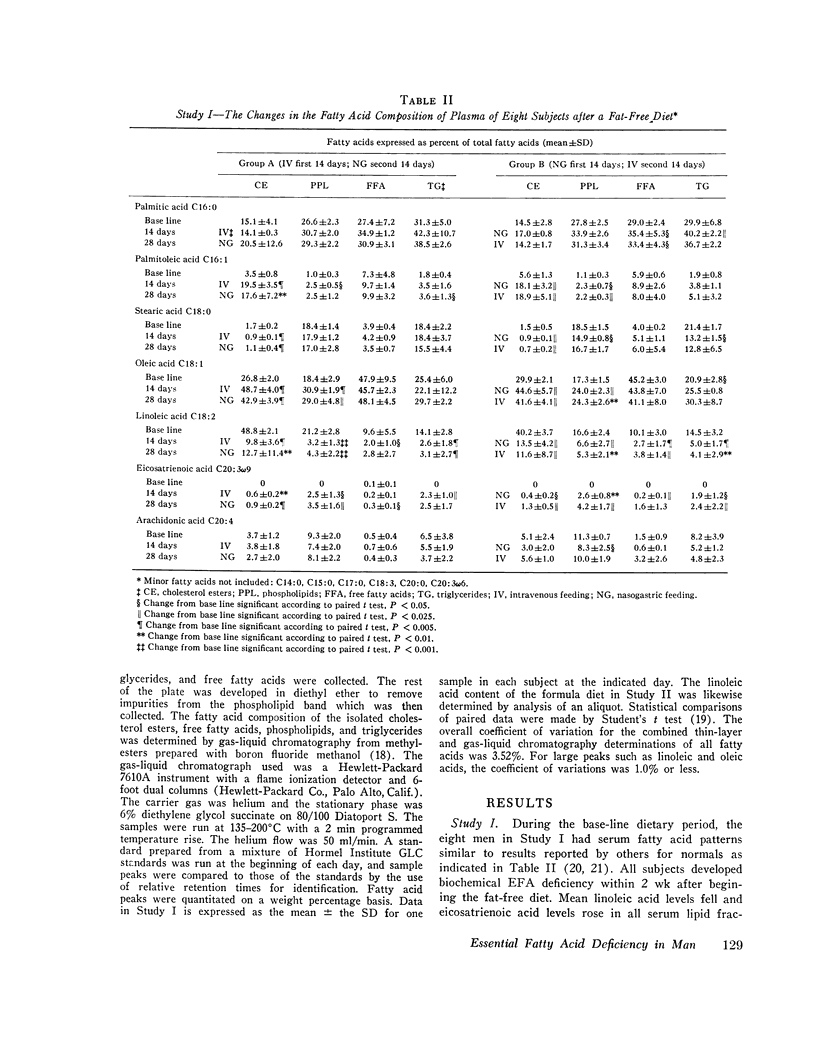
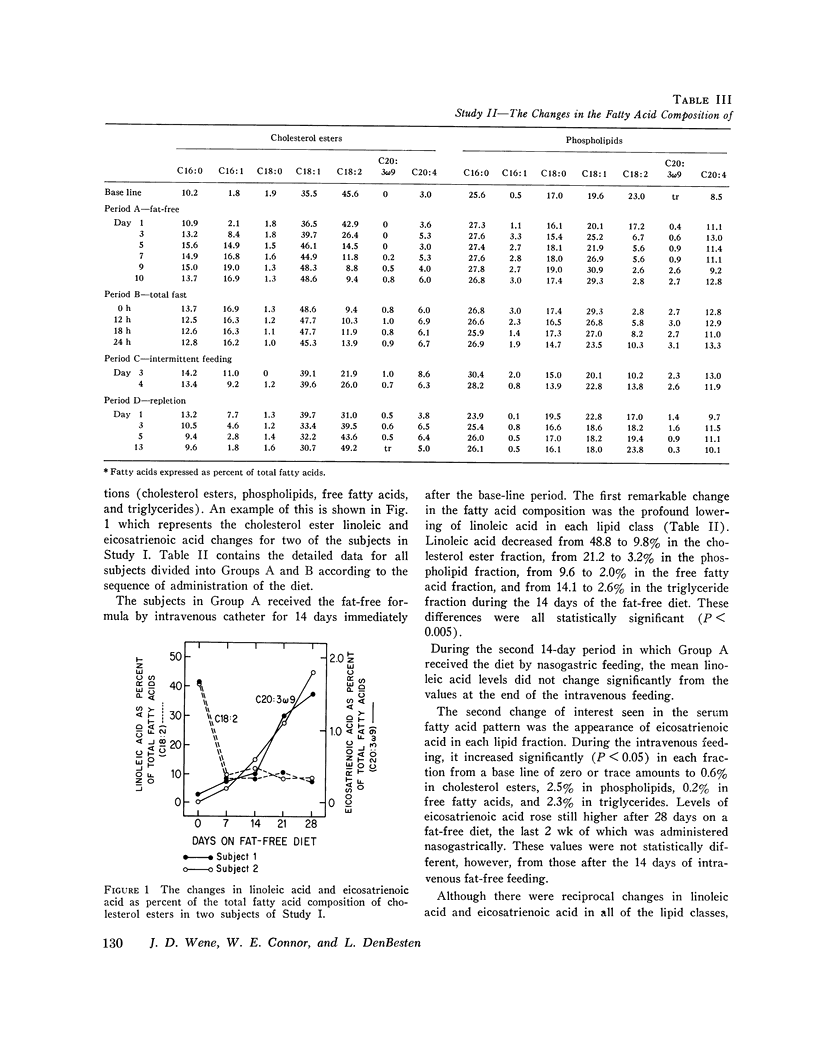
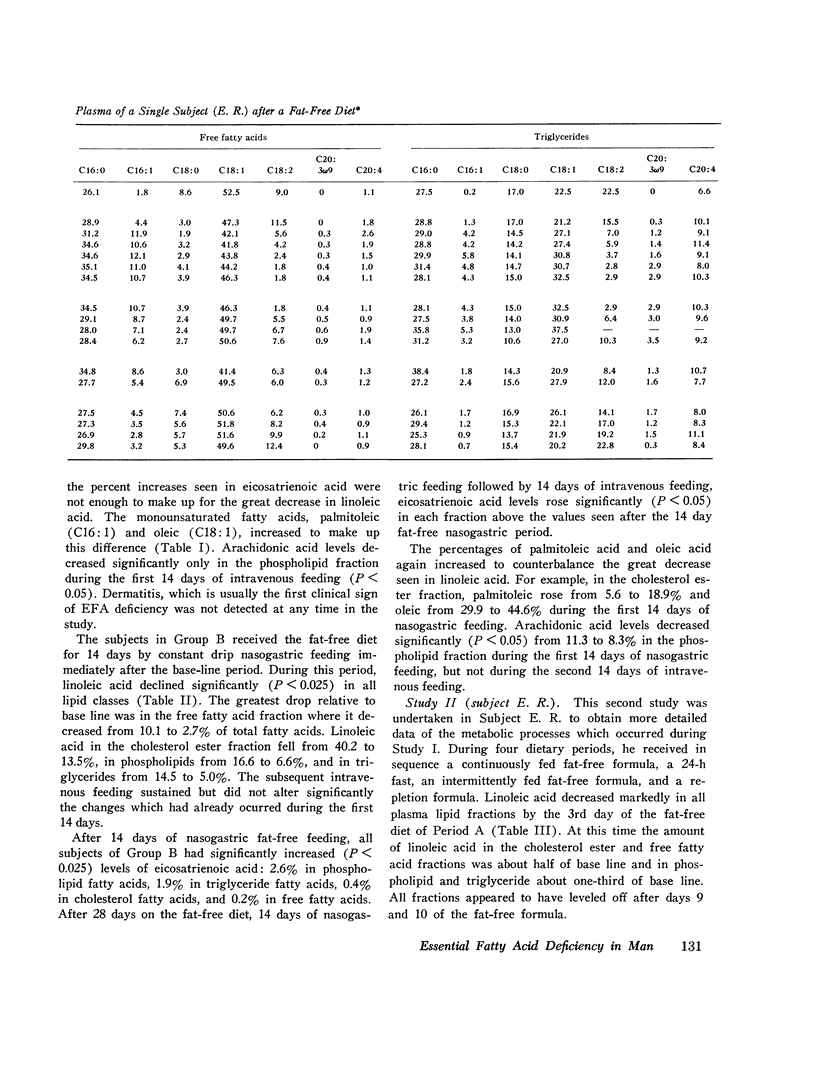
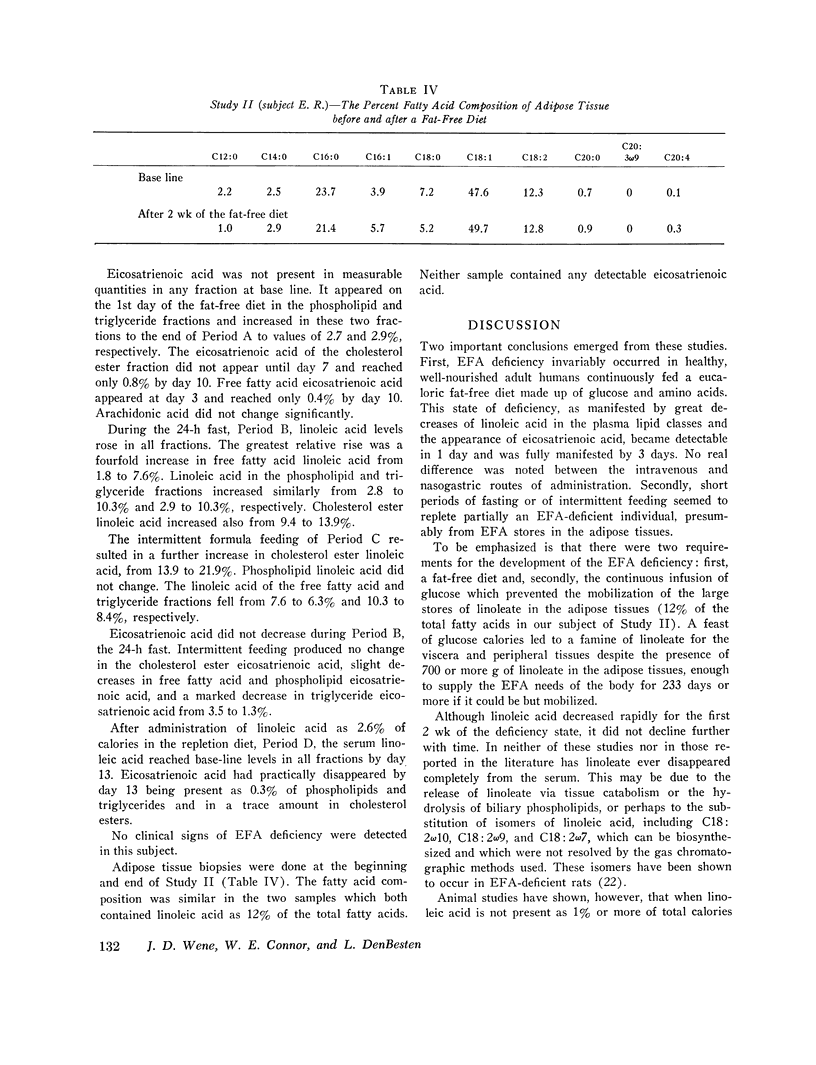
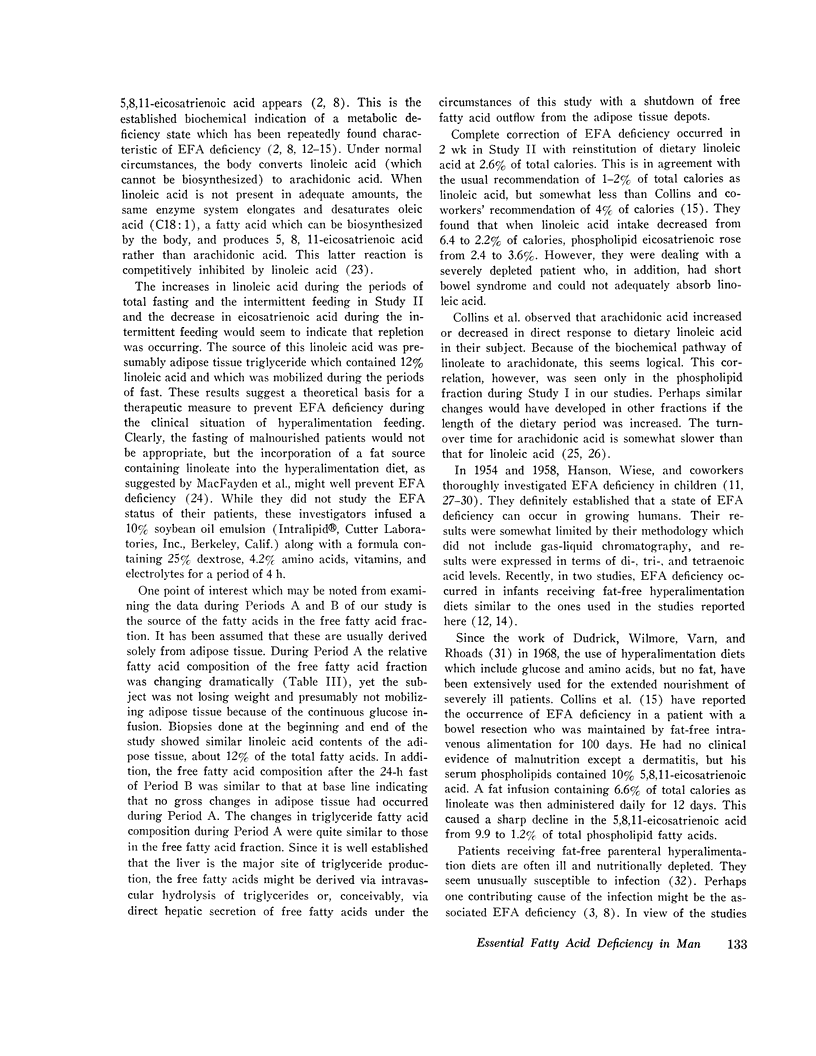

Selected References
These references are in PubMed. This may not be the complete list of references from this article.
- AAES-JORGENSEN E. Essential fatty acids. Physiol Rev. 1961 Jan;41:1–51. doi: 10.1152/physrev.1961.41.1.1. [DOI] [PubMed] [Google Scholar]
- ADAM D. J., HANSEN A. E., WIESE H. F. Essential fatty acids in infant nutrition. II. Effect of linoleic acid on caloric intake. J Nutr. 1958 Dec 10;66(4):555–564. doi: 10.1093/jn/66.4.555. [DOI] [PubMed] [Google Scholar]
- ANTONIS A., BERSOHN I. The influence of diet on serum lipids in South African white and Bantu prisoners. Am J Clin Nutr. 1962 Jun;10:484–499. doi: 10.1093/ajcn/10.6.484. [DOI] [PubMed] [Google Scholar]
- BRENNER R. R., NERVI A. M. KINETICS OF LINOLEIC AND ARACHIDONIC ACID INCORPORATION AND EICOSATRIENOIC DEPLETION IN THE LIPIDS OF FAT-DEFICIENT RATS FED METHYL LINOLEATE AND ARACHIDONATE. J Lipid Res. 1965 Jul;6:363–368. [PubMed] [Google Scholar]
- Caldwell M. D., Jonsson H. T., Othersen H. B., Jr Essential fatty acid deficiency in an infant receiving prolonged parenteral alimentation. J Pediatr. 1972 Nov;81(5):894–898. doi: 10.1016/s0022-3476(72)80539-0. [DOI] [PubMed] [Google Scholar]
- Collins F. D., Sinclair A. J., Royle J. P., Coats D. A., Maynard A. T., Leonard R. F. Plasma lipids in human linoleic acid deficiency. Nutr Metab. 1971;13(3):150–167. doi: 10.1159/000175332. [DOI] [PubMed] [Google Scholar]
- Coots R. H. Metabolism of arachidonic acid-1-14C in the rat. J Lipid Res. 1965 Oct;6(4):494–497. [PubMed] [Google Scholar]
- Craddock P. R., Yawata Y., VanSanten L., Gilberstadt S., Silvis S., Jacob H. S. Acquired phagocyte dysfunction. A complication of the hypophosphatemia of parenteral hyperalimentation. N Engl J Med. 1974 Jun 20;290(25):1403–1407. doi: 10.1056/NEJM197406202902504. [DOI] [PubMed] [Google Scholar]
- Dudrick S. J., Wilmore D. W., Vars H. M., Rhoads J. E. Long-term total parenteral nutrition with growth, development, and positive nitrogen balance. Surgery. 1968 Jul;64(1):134–142. [PubMed] [Google Scholar]
- Eaton H. D. Chronic bovine hypo- and hypervitaminosis A and cerebrospinal fluid pressure. Am J Clin Nutr. 1969 Aug;22(8):1070–1080. doi: 10.1093/ajcn/22.8.1070. [DOI] [PubMed] [Google Scholar]
- Guarnieri M., Johnson R. M. The essential fatty acids. Adv Lipid Res. 1970;8:115–174. doi: 10.1016/b978-0-12-024908-4.50010-6. [DOI] [PubMed] [Google Scholar]
- HANSEN A. E., HAGGARD M. E., BOELSCHE A. N., ADAM D. J., WIESE H. F. Essential fatty acids in infant nutrition. III. Clinical manifestations of linoleic acid deficiency. J Nutr. 1958 Dec 10;66(4):565–576. doi: 10.1093/jn/66.4.565. [DOI] [PubMed] [Google Scholar]
- HANSEN A. E., WIESE H. F. Essential fatty acids and human nutrition. II. Serum level for unsaturated fatty acids in poorly-nourished infants and children. J Nutr. 1954 Mar;52(3):367–374. doi: 10.1093/jn/52.3.367. [DOI] [PubMed] [Google Scholar]
- HANSEN A. E., WIESE H. F. Essential fatty acids and human nutrition. II. Serum level for unsaturated fatty acids in poorly-nourished infants and children. J Nutr. 1954 Mar;52(3):367–374. doi: 10.1093/jn/52.3.367. [DOI] [PubMed] [Google Scholar]
- MOHRHAUER H., HOLMAN R. T. ALTERATION OF THE FATTY ACID COMPOSITION OF BRAIN LIPIDS BY VARYING LEVELS OF DIETARY ESSENTIAL FATTY ACIDS. J Neurochem. 1963 Jul;10:523–530. doi: 10.1111/j.1471-4159.1963.tb09855.x. [DOI] [PubMed] [Google Scholar]
- MORRISON W. R., SMITH L. M. PREPARATION OF FATTY ACID METHYL ESTERS AND DIMETHYLACETALS FROM LIPIDS WITH BORON FLUORIDE--METHANOL. J Lipid Res. 1964 Oct;5:600–608. [PubMed] [Google Scholar]
- MacFadyen B. V., Jr, Dudrick S. J., Tagudar E. P., Maynard A. T., Law D. K., Rhoads J. E. Triglyceride and free fatty acid clearances in patients receiving complete parenteral nutrition using a ten per cent soybean oil emulsion. Surg Gynecol Obstet. 1973 Nov;137(5):813–815. [PubMed] [Google Scholar]
- Paulsrud J. R., Pensler L., Whitten C. F., Stewart S., Holman R. T. Essential fatty acid deficiency in infants induced by fat-free intravenous feeding. Am J Clin Nutr. 1972 Sep;25(9):897–904. doi: 10.1093/ajcn/25.9.897. [DOI] [PubMed] [Google Scholar]
- SAND D., SEN N., SCHLENK H. POSITIONAL ISOMERISM OF UNSATURATED FATTY ACIDS IN THE RAT. QUANTIFICATION OF ISOMERIC MIXTURES. J Am Oil Chem Soc. 1965 Jun;42:511–516. doi: 10.1007/BF02540093. [DOI] [PubMed] [Google Scholar]
- SPERRY W. M., BRAND F. C. The determination of total lipides in blood serum. J Biol Chem. 1955 Mar;213(1):69–76. [PubMed] [Google Scholar]
- WIESE H. F., GIBBS R. H., HANSEN A. E. Essential fatty acids and human nutrition. I. Serum level for unsaturated fatty acids in healthy children. J Nutr. 1954 Mar;52(3):355–365. doi: 10.1093/jn/52.3.355. [DOI] [PubMed] [Google Scholar]
- WIESE H. F., HANSEN A. E., ADAM D. J. Essential fatty acids in infant nutrition. I. Linoleic acid requirement in terms of serum di-, tri- and tetraenoic acid levels. J Nutr. 1958 Nov 10;66(3):345–360. doi: 10.1093/jn/66.3.345. [DOI] [PubMed] [Google Scholar]
- White H. B., Jr, Turner M. D., Turner A. C., Miller R. C. Blood lipid alterations in infants receiving intravenous fat-free alimentation. J Pediatr. 1973 Aug;83(2):305–313. doi: 10.1016/s0022-3476(73)80499-8. [DOI] [PubMed] [Google Scholar]


